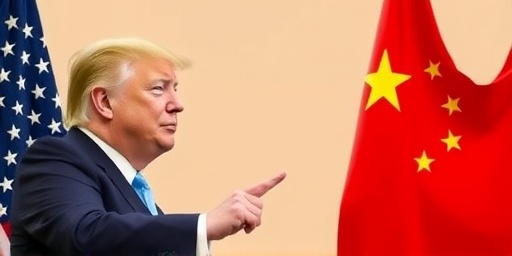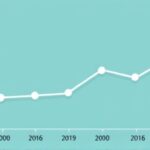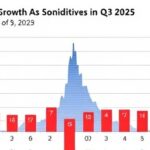Tariff Cut Eases U.S.-China trade Friction Following High-Stakes Presidential Talks
In a significant pivot in ongoing U.S.-China trade dynamics, President Donald Trump announced a reduction in tariffs on Chinese imports from 57% to 47% on Wednesday, just days after his virtual summit with Chinese President Xi Jinping. The move, hailed by White House officials as a ‘step toward mutual prosperity,’ comes amid escalating concerns over inflation and rising consumer prices in the U.S. economy. Early indicators from economic analysts suggest that while the adjustment may temper some pressures, businesses have already begun passing 20-40% of the previous tariff costs directly to American shoppers, exacerbating everyday expenses on everything from electronics to apparel.
- Tariff Cut Eases U.S.-China trade Friction Following High-Stakes Presidential Talks
- Businesses Pass 20-40% of Tariff Burdens to Consumers Amid Price Pressures
- Manufacturing Revival Hopes Rise with Adjusted Tariffs in U.S.-China Trade Arena
- Inflation Fears Linger as Experts Dissect Tariff Impacts on Broader Economy
- Future Trade Talks Signal Potential for Deeper U.S.-China Tariff Reforms
The announcement, delivered during a press briefing at the White House, underscores a potential thaw in the protracted U.S.-China trade war that has defined much of Trump’s economic agenda. ‘We’ve made real progress,’ Trump stated, emphasizing that the tariff rollback is contingent on China’s commitments to intellectual property protections and fair market access. Negotiators from both sides wrapped up the two-day talks late Tuesday, focusing on key sectors like manufacturing and technology, where tariffs have long stifled cross-border flows.
According to preliminary data from the U.S. Census Bureau, imports from China totaled $427 billion in the first half of the year, with tariffs contributing to a 12% uptick in overall import costs. Economists at the Peterson Institute for International Economics note that this reduction could save U.S. importers up to $15 billion annually, but the lingering effects of higher duties mean inflation remains a persistent threat. ‘This is a welcome relief, but it’s not a panacea,’ said Dr. Elena Ramirez, a trade policy expert at Georgetown University. ‘Consumers are still feeling the pinch from the tariffs that were in place.’
The U.S.-China trade relationship, valued at over $600 billion bilaterally last year, has been a flashpoint since 2018, when initial tariffs were imposed to address trade imbalances and protect domestic manufacturing. The recent adjustment reflects concessions from Beijing, including pledges to increase purchases of U.S. agricultural goods by 25%, a move aimed at bolstering American farmers hit hard by prior export restrictions.
Businesses Pass 20-40% of Tariff Burdens to Consumers Amid Price Pressures
As the dust settles on the tariff adjustment, new reports from retail giants like Walmart and Best Buy reveal how U.S.-China trade tariffs have infiltrated consumer prices. A survey conducted by the National Retail Federation indicates that 68% of retailers have absorbed only a fraction of the costs, with 20-40% shifted to end-users through subtle price hikes on imported goods. For instance, the average cost of a smartphone assembly component from China has risen 15% since the tariffs peaked, directly inflating consumer prices for devices that dominate the market.
In the manufacturing sector, companies reliant on Chinese supply chains are recalibrating operations. Ford Motor Company, which sources 30% of its auto parts from Asia, reported in its latest earnings call that tariff-related expenses added $1.2 billion to its overhead last quarter. ‘We’re optimistic about the reduction, but the pass-through to consumers has already happened,’ said CEO Jim Farley during the call. This sentiment echoes across industries; apparel maker Gap Inc. disclosed that clothing prices have increased by 8-12% in the past year, attributing much of it to tariffs on fabrics and dyes imported from China.
Inflation data from the Bureau of Labor Statistics supports these anecdotes. The Consumer Price Index (CPI) for imported goods climbed 4.2% year-over-year in July, with electronics and household appliances leading the surge at 6.5%. Economists warn that without further de-escalation, these trends could fuel broader inflation, potentially pushing the Federal Reserve to hike interest rates sooner than anticipated. ‘The tariffs are like a tax on American families,’ remarked Sen. Elizabeth Warren in a recent op-ed, calling for more aggressive reforms to shield consumer prices from international trade volatilities.
Small businesses, often the backbone of U.S. manufacturing, face unique challenges. The Small Business Administration reports that 45% of SMEs importing from China have seen profit margins shrink by 10-15% due to tariffs. Owners in states like California and Texas, hubs for tech and textile manufacturing, are lobbying for expedited tariff refunds, arguing that the 10% cut isn’t enough to reverse the damage. One such entrepreneur, Maria Gonzalez of a Los Angeles-based electronics firm, shared, ‘We’ve raised prices on our gadgets by 25% just to stay afloat. This adjustment helps, but consumers are paying the real price.’
Manufacturing Revival Hopes Rise with Adjusted Tariffs in U.S.-China Trade Arena
The tariff reduction is injecting fresh optimism into the U.S. manufacturing landscape, long strained by U.S.-China trade barriers. Industry leaders from the National Association of Manufacturers (NAM) predict a 5-7% boost in domestic production capacity over the next year, as lower duties encourage reshoring of supply chains. ‘This is a game-changer for American workers,’ NAM President Jay Timmons said in a statement. ‘It levels the playing field without completely dismantling protections.’
Key manufacturing sectors stand to benefit most. In steel and aluminum, where tariffs originated as safeguards against Chinese dumping, the adjustment could reduce input costs by 8%, per estimates from the American Iron and Steel Institute. Companies like Nucor Corp. are already expanding facilities in the Midwest, citing improved trade conditions. Similarly, the semiconductor industry, vital to both nations, anticipates smoother exports; Intel reported potential savings of $500 million if tariffs stabilize at 47%.
However, challenges persist. Labor costs in the U.S. remain 20-30% higher than in China, making full-scale manufacturing repatriation a gradual process. A report from McKinsey & Company highlights that while tariffs have spurred $200 billion in new U.S. investments since 2018, supply chain disruptions from the COVID-19 pandemic have compounded issues. ‘Manufacturing is rebounding, but inflation from tariffs could erode those gains if consumer prices keep climbing,’ noted analyst Tom Ortega.
Regional impacts vary. In the Rust Belt states of Ohio and Pennsylvania, where manufacturing employs over 1 million, the tariff cut is viewed as a lifeline. Local unions, including the United Steelworkers, have praised the move but urged vigilance on enforcement. ‘We’ve lost jobs to unfair trade practices; this reduction must come with ironclad commitments from China,’ said union president David McCall. On the West Coast, tech manufacturing hubs like Silicon Valley are diversifying suppliers to Vietnam and Mexico, reducing reliance on Chinese imports by 15% in recent months.
Inflation Fears Linger as Experts Dissect Tariff Impacts on Broader Economy
While the tariff slash offers short-term relief, experts are closely monitoring its ripple effects on inflation and consumer prices. The Federal Reserve’s latest Beige Book notes ‘modest upward pressure’ on prices due to U.S.-China trade tariffs, with 22 of 25 industries reporting cost increases passed to consumers. Goldman Sachs economists forecast that the 10% reduction could shave 0.3 percentage points off annual inflation, but persistent tariffs at 47% might still add $400 annually to the average household’s expenses.
Consumer behavior is shifting in response. Nielsen data shows a 10% dip in demand for tariff-affected goods like toys and furniture, as shoppers opt for domestic alternatives or delay purchases amid rising prices. ‘Inflation isn’t just numbers; it’s families cutting back on essentials,’ said Consumer Reports’ executive director Scott Flurry. This caution is evident in retail sales, which grew only 1.1% last month, the slowest pace in a year.
Global perspectives add complexity. The World Trade Organization (WTO) has criticized the tariffs as distortive, estimating they cost the global economy $100 billion in lost efficiency. China’s Ministry of Commerce responded positively to the adjustment, vowing to ‘reciprocate with openness,’ but analysts remain skeptical. ‘Beijing’s promises are often more rhetoric than reality,’ quipped trade consultant Li Wei from Beijing.
In Washington, bipartisan support for monitoring is growing. House Ways and Means Committee Chair Richard Neal introduced legislation to cap future tariff pass-throughs to consumers, emphasizing protections for low-income households most vulnerable to inflation spikes. ‘U.S.-China trade must benefit all Americans, not just corporations,’ Neal asserted.
Future Trade Talks Signal Potential for Deeper U.S.-China Tariff Reforms
Looking ahead, the tariff adjustment paves the way for more substantive U.S.-China trade negotiations, with both leaders committing to quarterly reviews starting in October. White House trade advisor Robert Lighthizer indicated that further reductions could follow if China meets benchmarks on subsidies and currency practices. ‘This is phase one of a multi-step process,’ Lighthizer told reporters, hinting at possible drops to 30% by mid-2024.
For manufacturing, this could mean accelerated investments. The U.S. Chamber of Commerce projects 500,000 new jobs in the sector if tariffs continue to ease, focusing on high-tech areas like electric vehicles and renewables. However, geopolitical tensions, including Taiwan Strait disputes, could derail progress. ‘Trade and security are intertwined; any escalation risks reversing these gains,’ warned Brookings Institution fellow Ryan Hass.
Consumers may see relief by holiday season, with retailers like Target promising to roll back some price increases. Yet, long-term inflation control hinges on diversified supply chains. Initiatives like the CHIPS Act, allocating $52 billion to domestic semiconductor manufacturing, aim to reduce U.S.-China trade dependencies. As one economist put it, ‘The tariff cut is a bandage; true healing requires strategic decoupling.’
Stakeholders across the board are preparing for uncertainty. Farmers in Iowa, buoyed by China’s ag purchase pledges, are planting more soybeans, while exporters eye new markets in Europe. Ultimately, the success of this adjustment will be measured not just in economic metrics, but in whether it fosters a more balanced U.S.-China trade environment that curbs inflation and stabilizes consumer prices for years to come.









